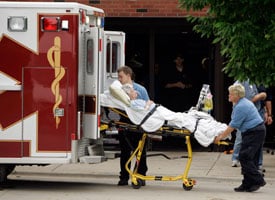For people in New Orleans, images from the current Midwest flooding disaster are bringing back painful memories of 2005 and Hurricane Katrina. Many of the failures of the governmental and private response to that disaster occurred in the realm of healthcare. Sick and vulnerable individuals in hospitals, nursing homes and in private homes and shelters spent days awaiting life-saving evacuations and assistance, with deadly consequences.
What impact have the lessons learned from Katrina been having on the medical response to the current crisis? We put that question to officials from the Office for Preparedness and Emergency Operations at the U.S. Department of Health and Human Services. They told us that an intense effort to improve coordination between federal and state emergency officials since Katrina has been effective. "This is a much more eloquent operation," said Dr. Tom Sizemore, the office's principal deputy director.
HHS has sent additional personnel to the flood zone and declared a public health emergency in several states, helping to improve healthcare access for Medicare and Medicaid beneficiaries. Sizemore told us his office is monitoring flood-threatened health and nursing home facilities, and has offered to supply Disaster Medical Assistance Teams and other forms of support. Thus far no states have requested them. "There's not a lot of requirement for federal assistance, at least in the healthcare arena," Sizemore said. The states are "doing a tremendous job managing their own assets."
 A case in point is the evacuation of Mercy Medical Center in Cedar Rapids late last week. Within a period of several hours, hospital staff, state and local officials, ambulance companies, the Iowa National Guard, and volunteers cooperated to transport all of the hospital's 176 patients, including those in critical care units and a nursing facility, to nearby facilities as the flood waters rose. Mercy spokeswoman Karen Vander Sanden told us that regular disaster drills, including one planned for the very day the evacuation took place, had improved preparedness. She said there were no deaths during the evacuation.
A case in point is the evacuation of Mercy Medical Center in Cedar Rapids late last week. Within a period of several hours, hospital staff, state and local officials, ambulance companies, the Iowa National Guard, and volunteers cooperated to transport all of the hospital's 176 patients, including those in critical care units and a nursing facility, to nearby facilities as the flood waters rose. Mercy spokeswoman Karen Vander Sanden told us that regular disaster drills, including one planned for the very day the evacuation took place, had improved preparedness. She said there were no deaths during the evacuation.
The same was true at Colombus Regional Hospital in Indiana-which safely evacuated its 157 patients. Assistance to other hospitals and nursing homes that have sustained damage in recent days has likewise been managed on a state level, according to Capt. Ann Knebel, Deputy Director for Preparedness Planning in the Office of Preparedness and Emergency Operations at HHS. "They said we're able to handle it," she said. "That's exactly where we're trying to get to." Knebel said that state and local disaster preparedness grants distributed by the federal government in recent years have made a difference.
A question that arises is whether a similarly robust disaster medical response would be fielded in other parts of the country, where federal assets might be needed and where state and local governments might be less functional. It may take another disaster to find out. In the meantime, we wish all of those involved in the response to the Midwest flooding the best with their vital work. We will continue to follow the results.



